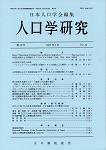Volume 58
Displaying 1-22 of 22 articles from this issue
- |<
- <
- 1
- >
- >|
Index
-
Article type: Index
2022Volume 58 Pages Cover1-
Published: 2022
Released on J-STAGE: November 18, 2022
Download PDF (1611K)
Presidential Address
-
Article type: Presidential Address
2022Volume 58 Pages 1-12
Published: 2022
Released on J-STAGE: November 18, 2022
Download PDF (948K)
Article
-
Article type: Article
2022Volume 58 Pages 13-28
Published: 2022
Released on J-STAGE: November 18, 2022
Advance online publication: January 27, 2022Download PDF (2226K) -
Article type: Article
2022Volume 58 Pages 29-50
Published: 2022
Released on J-STAGE: November 18, 2022
Advance online publication: April 19, 2022Download PDF (1733K)
Note
-
Article type: Note
2022Volume 58 Pages 51-65
Published: 2022
Released on J-STAGE: November 18, 2022
Advance online publication: June 02, 2022Download PDF (964K)
Book Reviews
-
Article type: Book Review
2022Volume 58 Pages 67-69
Published: 2022
Released on J-STAGE: November 18, 2022
Download PDF (921K) -
Article type: Book Review
2022Volume 58 Pages 70-73
Published: 2022
Released on J-STAGE: November 18, 2022
Download PDF (926K) -
Article type: Book Review
2022Volume 58 Pages 74-77
Published: 2022
Released on J-STAGE: November 18, 2022
Download PDF (910K) -
Article type: Book Review
2022Volume 58 Pages 78-80
Published: 2022
Released on J-STAGE: November 18, 2022
Download PDF (923K) -
Article type: Book Review
2022Volume 58 Pages 81-84
Published: 2022
Released on J-STAGE: November 18, 2022
Download PDF (909K) -
Article type: Book Review
2022Volume 58 Pages 85-87
Published: 2022
Released on J-STAGE: November 18, 2022
Download PDF (920K) -
Article type: Book Review
2022Volume 58 Pages 88-90
Published: 2022
Released on J-STAGE: November 18, 2022
Download PDF (919K) -
Article type: Book Review
2022Volume 58 Pages 91-93
Published: 2022
Released on J-STAGE: November 18, 2022
Download PDF (920K) -
Article type: Book Review
2022Volume 58 Pages 94-97
Published: 2022
Released on J-STAGE: November 18, 2022
Download PDF (926K) -
Article type: Short Reviews
2022Volume 58 Pages 98-108
Published: 2022
Released on J-STAGE: November 18, 2022
Download PDF (953K)
PAJ Information
-
Article type: PAJ Information
2022Volume 58 Pages 109-118
Published: 2022
Released on J-STAGE: November 18, 2022
Download PDF (923K) -
Article type: Regional Meetings of the Population Association of Japan
2022Volume 58 Pages 119-122
Published: 2022
Released on J-STAGE: November 18, 2022
Download PDF (911K) -
Article type: Regional Meetings of the Population Association of Japan
2022Volume 58 Pages 123-128
Published: 2022
Released on J-STAGE: November 18, 2022
Download PDF (920K) -
Article type: Regional Meetings of the Population Association of Japan
2022Volume 58 Pages 128-132
Published: 2022
Released on J-STAGE: November 18, 2022
Download PDF (913K) -
2022Volume 58 Pages 133-143
Published: 2022
Released on J-STAGE: November 18, 2022
Download PDF (941K) -
2022Volume 58 Pages 144-149
Published: 2022
Released on J-STAGE: November 18, 2022
Download PDF (921K) -
2022Volume 58 Pages Cover2-
Published: 2022
Released on J-STAGE: November 18, 2022
Download PDF (1571K)
- |<
- <
- 1
- >
- >|
